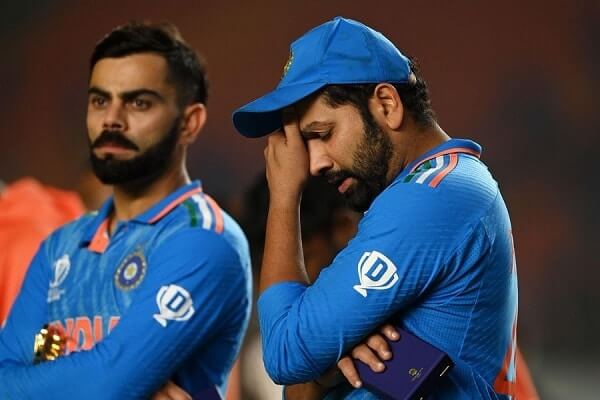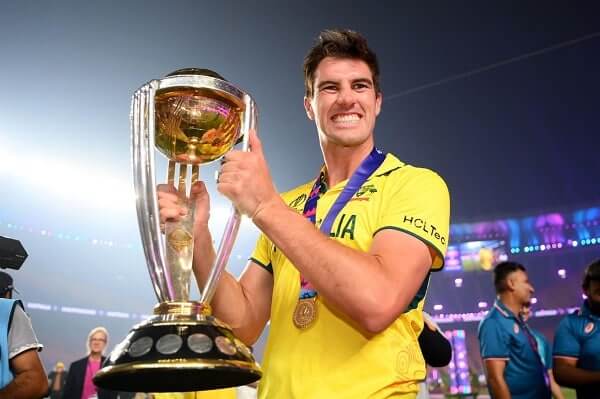Much like England’s dramatic 2019 World Cup triumph, Australia’s staggering sixth ICC Cricket World Cup 2023 crown delivered a story for the ages, in a tournament that seemed destined as a coronation for the Kohli / Sharma era of Indian cricket.
There were plenty of memorable moments, but it’s time to take a look at the key takeaways from this edition:
Perfect Pat: Cummins cements his legacy as a great
It’s entirely possible that no captain will ever again emulate what Pat Cummins has managed in 2023, having retained the Ashes, and won both an ICC World Test Championship and ICC Cricket World Cup – in each case away from home.
Impressively, Cummins did so in the face of unrelenting and often unfair criticism. While cricket captains are rightly subject to greater scrutiny than captains in other sports, for various reasons Cummins appears destined to be given an especially short leash – whether because he is a rare fast-bowling captain, viewed as strategically unimaginative, or considered too “woke”.
Yet what Cummins and his team delivered in the ICC Cricket World Cup final was one of the most strategically perfect cricketing performances in the history of one-day international cricket, and Cummins led from the front with the ball, as well as in the way he used his bowlers.
Best feeling in the world! 🏆 #CWC23 pic.twitter.com/qUe7vX5rFw
— Pat Cummins (@patcummins30) November 19, 2023
He may have done it all with a smile on his face, but make no mistake: Pat Cummins is as tough as they come, and he has now cemented his legacy as one of the great leaders of his time.
India shoots itself in the foot… again
At some point in the future, it may become apparent to India’s army of coaching staff and to the BCCI more generally: slower, lower pitches are no friend to modern India.
In years gone by, India has of course struggled with pace bowling; the best evidence being that India’s current crop of fast bowlers would walk into any Indian team of the preceding 50 years. And as India’s batters have become accustomed to playing quality pace bowling in the nets, it follows that India’s batters have become more prolific against fast bowling in match conditions.

In fact, some have become reliant on pace – look no further than the likes of Shubman Gill, Shreyas Iyer and Suryakumar Yadav, each of whom enjoys using the pace of the ball in how they bat, and each of whom failed in the final on a slow, dead wicket.
While casual cricket supporters will typically complain about “pitch doctoring”, those who truly understand the game will appreciate the irony: because the slower the pitch, the more level the playing field and, given the dew factor in India, the more likely the match will be decided by the toss.
South Africa: don’t say the C-word
South Africa cannot catch a break when it comes to World Cup semi-finals. Their defeat to Australia this edition marked the Proteas’ seventh defeat from seven World Cup semi-finals.
It’s perhaps one of the longest losing finals streaks in professional sport, and has been marked over the years by scarcely believable losses from seemingly unassailable positions.
With no expectations placed on South Africa leading into the tournament – given its penchant for self-capitulation – the side largely went under the radar while dominating the group stages, barring a hiccup against the Netherlands and a horrific loss to India. Boasting a positively fearsome batting order and a quality bowling lineup, leading into the semi-finals the side appeared destined to go one step further.
But the batting order failed at the worst possible time once again, against a rampant Australian attack. While it marked yet another failure for South Africa at the semi-final stage, whether it was a true “choke” is open for debate, because – unlike several occasions in years gone by – this time South Africa never looked in control of the game before losing it.
As disappointed as we are about the result, I am simultaneously very proud of this team and the cricket we played 🇿🇦 Thank you India for your warm hospitality and to everyone who sent messages of support. We look forward with hope and excitement ✊ @ProteasMenCSA @ICC pic.twitter.com/HjIBN5ee2L
— Gerald Coetzee (@GeraldCoetzee62) November 21, 2023
There are no minnows
Historically, lower-ranked cricket nations have either been discarded as Associate nations, or “minnows”.
The 2023 World Cup proved once again that, given an opportunity, these sides have the capability to match it with the best.
In previous World Cups, those victories have been mere flashes in the pan; think Bangladesh over India in 2007, and Netherlands and Ireland over England in 2011, and Ireland over the West Indies in 2015.
This year was different, however, with Afghanistan demonstrating sustained and consistent success to come sixth – and very nearly qualifying for the semi-finals along the way, but for Glenn Maxwell’s miracle knock of 201*.
ICYMI: Here’s how the cricketing fraternity reacted to Afghanistan’s memorable journey at the ICC Men’s Cricket World Cup 2023. 👍#AfghanAtalan | #CWC23 | #WarzaMaidanGata pic.twitter.com/N54LKiEaaa
— Afghanistan Cricket Board (@ACBofficials) November 11, 2023
It’s a reminder that playing in a World Cup is no longer a right, but a privilege, given the qualification pathways that teams have to go through. Just ask the West Indies, who missed a World Cup for the first time in history after a disastrous qualifying campaign.
It’s also yet another wake-up call for teams and fans who might otherwise take lower-ranked nations lightly.
READ ALSO: Australia wins 2023 ICC World Cup Final against India




